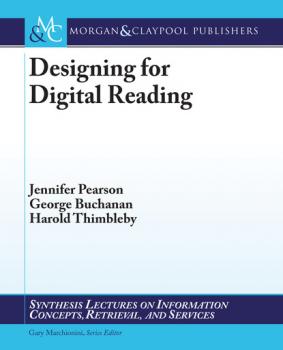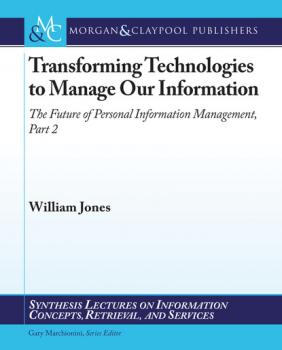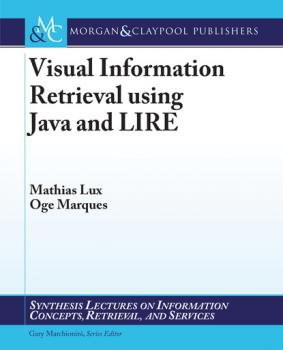ТОП просматриваемых книг сайта:















Программы
Различные книги в жанре Программы, доступные для чтения и скачиванияDesigning for Digital Reading - Harold Thimbleby
Synthesis Lectures on Information Concepts, Retrieval, and ServicesАннотация
The physical properties of paper (for example, it is light, thin, and flexible) contribute to the ease with which physical documents are manipulated; but these properties have a completely different set of affordances to their digital equivalents. Paper can be folded, ripped, or scribbled on almost subconsciously – activities that require significant cognitive attention in their digital form, if they are even possible. The nearly subliminal interaction that comes from years of learned behavior with paper has been described as lightweight interaction, which is achieved when a person actively reads an article in a way that is so easy and unselfconscious that they are not apt to remember their actions later.
Reading is now in a period of rapid change, and digital text is fast becoming the predominant mode of reading. As a society, we are merely at the start of the journey of designing truly effective tools for handling digital text.
This book investigates the advantages of paper, how the affordances of paper can be realized in digital form, and what forms best support lightweight interaction for active reading. To understand how to design for the future, we review the ways reading technology and reader behavior have both changed and remained constant over hundreds of years. We explore the reasoning behind reader behavior and introduce and evaluate several user interface designs that implement these lightweight properties familiar from our everyday use of paper.
We start by looking back, reviewing the development of reading technology and the progress of research on reading over many years. Drawing key concepts from this review, we move forward to develop and test methods for creating new and more effective interactions for supporting digital reading. Finally, we lay down a set of lightweight attributes which can be used as evidence-based guidelines to improve the usability of future digital reading technologies. By the end of this book, then, we hope you will be equipped to critique the present state of digital reading, and to better design and evaluate new interaction styles and technologies.
Table of Contents: Preface / Acknowledgments / Figure Credits / Introduction / Reading Through the Ages / Key Concepts / Lightweight Interactions / Improving Digital Reading / Bibliography / Authors' Biographies
Информация о книге
Автор произведения Harold Thimbleby
Жанр Программы
Серия Synthesis Lectures on Information Concepts, Retrieval, and Services
Аннотация
Following the recent publication of the PROV standard for provenance on the Web, which the two authors actively help shape in the Provenance Working Group at the World Wide Web Consortium, this Synthesis lecture is a hands-on introduction to PROV aimed at Web and linked data professionals. By means of recipes, illustrations, a website at www.provbook.org, and tools, it guides practitioners through a variety of issues related to provenance: how to generate provenance, publish it on the Web, make it discoverable, and how to utilize it. Equipped with this knowledge, practictioners will be in a position to develop novel applications that can bring open-ness, trust, and accountability.
Table of Contents: Preface / Acknowledgments / Introduction / A Data Journalism Scenario / The PROV Ontology / Provenance Recipes / Validation, Compliance, Quality, Replay / Provenance Management / Conclusion / Bibliography / Authors' Biographies / Index
Информация о книге
Автор произведения Luc Moreau
Жанр Программы
Серия Synthesis Lectures on the Semantic Web: Theory and Technology
Library Linked Data in the Cloud - Shenghui Wang
Synthesis Lectures on the Semantic Web: Theory and TechnologyАннотация
The linked data architecture has achieved critical mass just as it has become clear that library standards for resource description are nearing obsolescence. Working for the world’s largest library cooperative, OCLC researchers have been active participants in the development of next-generation standards for library resource description. By engaging with an international community of library and Web standards experts, they have published some of the most widely used RDF datasets representing library collections and librarianship.
This book focuses on the conceptual and technical challenges involved in publishing linked data derived from traditional library metadata. This transformation is a high priority because most searches for information start not in the library, nor even in a Web-accessible library catalog, but elsewhere on the Internet. Modeling data in a form that the broader Web understands will project the value of libraries into the Digital Information Age.
The exposition is aimed at librarians, archivists, computer scientists, and other professionals interested in modeling bibliographic descriptions as linked data. It aims to achieve a balanced treatment of theory, technical detail, and practical application.
Информация о книге
Автор произведения Shenghui Wang
Жанр Программы
Серия Synthesis Lectures on the Semantic Web: Theory and Technology
Transforming Technologies to Manage Our Information - William Jones
Synthesis Lectures on Information Concepts, Retrieval, and ServicesАннотация
Part 2 provides a more focused look at technologies for managing information that promise to profoundly alter our practices of PIM and, through these practices, the way we lead our lives.
Part 2 is in five chapters:
– Chapter 5. Technologies of Input and Output. Technologies in support of gesture, touch, voice, and even eye movements combine to support a more natural user interface (NUI). Technologies of output include glasses and «watch» watches. Output will also increasingly be animated with options to «zoom».
– Chapter 6. Technologies to Save Our Information. We can opt for «life logs» to record our experiences with increasing fidelity. What will we use these logs for? And what isn’t recorded that should be?
– Chapter 7. Technologies to Search Our Information. The potential for personalized search is enormous and mostly yet to be realized. Persistent searches, situated in our information landscape, will allow us to maintain a diversity of projects and areas of interest without a need to continually switch from one to another to handle incoming information.
– Chapter 8. Technologies to Structure Our Information. Structure is key if we are to keep, find, and make effective use of our information. But how best to structure? And how best to share structured information between the applications we use, with other people, and also with ourselves over time? What lessons can we draw from the failures and successes in web-based efforts to share structure?
– Chapter 9. PIM Transformed and Transforming: Stories from the Past, Present and Future. Part 2 concludes with a comparison between Licklider’s world of information in 1957 and our own world of information today. And then we consider what the world of information is likely to look like in 2057. Licklider estimated that he spent 85% of his «thinking time» in activities that were clerical and mechanical and might (someday) be delegated to the computer. What percentage of our own time is spent with the clerical and mechanical? What about in 2057?
Table of Contents: Technologies of Input and Output / Technologies to Save Our Information / Technologies to Search Our Information / Technologies to Structure Our Information / PIM Transformed and Transforming: Stories from the Past, Present, and Future
Информация о книге
Автор произведения William Jones
Жанр Программы
Серия Synthesis Lectures on Information Concepts, Retrieval, and Services
Incentive-Centric Semantic Web Application Engineering - Elena Simperl
Synthesis Lectures on the Semantic Web: Theory and TechnologyАннотация
Информация о книге
Автор произведения Elena Simperl
Жанр Программы
Серия Synthesis Lectures on the Semantic Web: Theory and Technology
Аннотация
Sentiment analysis systems are being applied in almost every business and social domain because opinions are central to almost all human activities and are key influencers of our behaviors. Our beliefs and perceptions of reality, and the choices we make, are largely conditioned on how others see and evaluate the world. For this reason, when we need to make a decision we often seek out the opinions of others. This is true not only for individuals but also for organizations.
This book is a comprehensive introductory and survey text. It covers all important topics and the latest developments in the field with over 400 references. It is suitable for students, researchers and practitioners who are interested in social media analysis in general and sentiment analysis in particular. Lecturers can readily use it in class for courses on natural language processing, social media analysis, text mining, and data mining. Lecture slides are also available online.
Table of Contents: Preface / Sentiment Analysis: A Fascinating Problem / The Problem of Sentiment Analysis / Document Sentiment Classification / Sentence Subjectivity and Sentiment Classification / Aspect-Based Sentiment Analysis / Sentiment Lexicon Generation / Opinion Summarization / Analysis of Comparative Opinions / Opinion Search and Retrieval / Opinion Spam Detection / Quality of Reviews / Concluding Remarks / Bibliography / Author Biography
Resource-Oriented Architecture Patterns for Webs of Data - Brian Sletten
Synthesis Lectures on the Semantic Web: Theory and TechnologyАннотация
Table of Contents: List of Figures / Informational Patterns / Applicative Patterns / Procedural Patterns
Информация о книге
Автор произведения Brian Sletten
Жанр Программы
Серия Synthesis Lectures on the Semantic Web: Theory and Technology
Аннотация
This book explains the RTE task formulation adopted by the NLP research community, and gives a clear overview of research in this area. It draws out commonalities in this research, detailing the intuitions behind dominant approaches and their theoretical underpinnings.
This book has been written with a wide audience in mind, but is intended to inform all readers about the state of the art in this fascinating field, to give a clear understanding of the principles underlying RTE research to date, and to highlight the short- and long-term research goals that will advance this technology.
Table of Contents: List of Figures / List of Tables / Preface / Acknowledgments / Textual Entailment / Architectures and Approaches / Alignment, Classification, and Learning / Case Studies / Knowledge Acquisition for Textual Entailment / Research Directions in RTE / Bibliography / Authors' Biographies
Visual Information Retrieval using Java and LIRE - Mathias Lux
Synthesis Lectures on Information Concepts, Retrieval, and ServicesАннотация
The goal of VIR is to retrieve matches ranked by their relevance to a given query, which is often expressed as an example image and/or a series of keywords. During its early years (1995-2000), the research efforts were dominated by content-based approaches contributed primarily by the image and video processing community. During the past decade, it was widely recognized that the challenges imposed by the lack of coincidence between an image's visual contents and its semantic interpretation, also known as semantic gap, required a clever use of textual metadata (in addition to information extracted from the image's pixel contents) to make image and video retrieval solutions efficient and effective. The need to bridge (or at least narrow) the semantic gap has been one of the driving forces behind current VIR research. Additionally, other related research problems and market opportunities have started to emerge, offering a broad range of exciting problems for computer scientists and engineers to work on.
In this introductory book, we focus on a subset of VIR problems where the media consists of images, and the indexing and retrieval methods are based on the pixel contents of those images – an approach known as content-based image retrieval (CBIR). We present an implementation-oriented overview of CBIR concepts, techniques, algorithms, and figures of merit. Most chapters are supported by examples written in Java, using Lucene (an open-source Java-based indexing and search implementation) and LIRE (Lucene Image REtrieval), an open-source Java-based library for CBIR.
Информация о книге
Автор произведения Mathias Lux
Жанр Программы
Серия Synthesis Lectures on Information Concepts, Retrieval, and Services
Аннотация
Table of Contents: List of Figures / Introduction / Principles of Linked Data / The Web of Data / Linked Data Design Considerations / Recipes for Publishing Linked Data / Consuming Linked Data / Summary and Outlook










